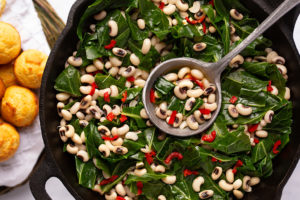
When we think of comfort food, our minds drift to memories of home, family, childhood, full bellies and contentment from a welcoming place.
Southern cooking has long been associated with cooking from the heart, but it isn’t always good for the heart. Fried chicken, buttermilk biscuits with gravy, and sauteed greens are staples of the Southern menu, but they’re often made with ingredients high in fat, sodium and cholesterol.
Those ingredients can increase the risk of diabetes, high blood pressure, high cholesterol and obesity— diseases that increase the risk of heart failure.
The old saying, “Moderation is key,” very much applies to our diet.
By focusing on balance with our meal planning and swapping in healthy ingredients for unhealthy ones, we can experience Southern cooking flavors that are healthier for the heart.
Let veggies shine
Make vegetables the main attraction, not a side note. Southern cooking roots stem from simple, plant-based ingredients that were accented with protein to add flavor to the meal.
Choose fresh or no-salt frozen vegetables, or no-sodium canned vegetables. They can be sautéed, steamed or roasted. It’s recommended you steam collard greens and other greens.
Get the good fats
You’ve probably heard someone say, “Fat makes everything taste better.” It may sound true, but the heart may not necessarily agree depending on the type of fat.
A good rule: Stay away from oil-fried foods and stick to good-for-you fats. Instead of using margarine, regular butter or shortening—which can put more strain on your heart—try using olive oil, canola oil or avocado oil as a source of fat.
Along with the fat source, the method of cooking can impact calorie intake. Try instead to bake, roast, grill, poach, boil or oven-fry.
Experiment
There is a world of flavor beyond salt. We want the zing when eating, but you can use more than just salt to heighten the taste of your meal.
Try using lemon, lime, orange zest, mustards, fruity vinegars, herbs and spices. You don’t need to completely remove salt from your diet. It’s all about moderation.
Eat healthier protein
Try adding more beans, peas, legumes and nuts to your daily diet as an alternative to animal-based proteins. If you want animal-based proteins, try adding more fish—fresh or canned—and choose lean cuts of beef or pork. (Check out this black-eyed pea salad for a mouth-watering example of protein with greens.)
With poultry, try skinless meat. Limit your consumption of bacon, sausage and hot dogs.
Grains? Choose whole over refined
Skip the white rice and white bread and opt instead for brown rice and whole grain. It has more fiber, vitamins and minerals compared to its more processed counterpart.
Fiber has been shown to help reduce cholesterol while lowering the risk of stroke and heart disease. It will also help you feel full longer—so it’ll stretch your budget, not your waistband.
 /a>
/a>
 /a>
/a>
 /a>
/a>